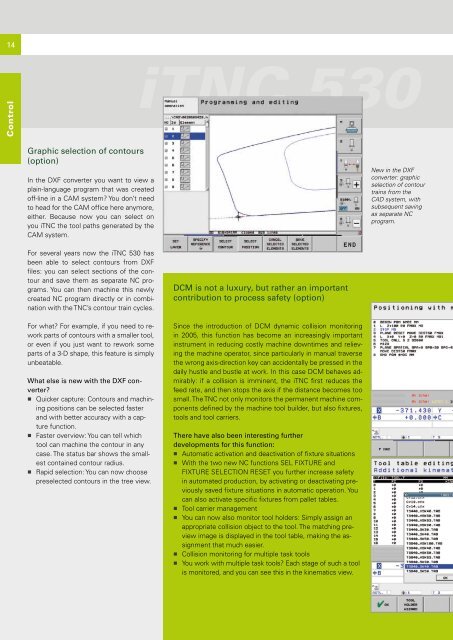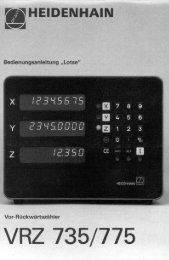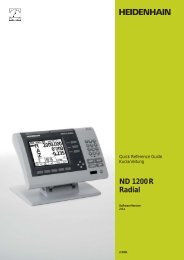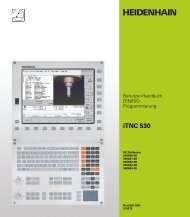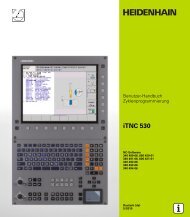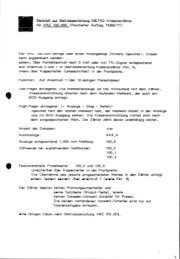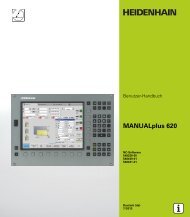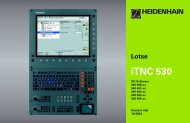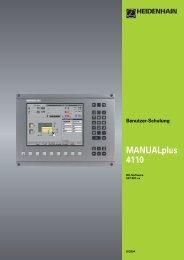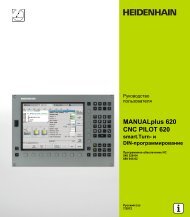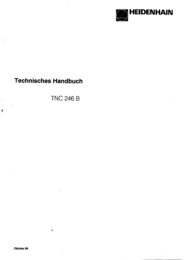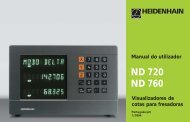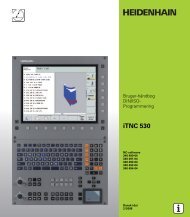Klartext 54 - heidenhain - DR. JOHANNES HEIDENHAIN GmbH
Klartext 54 - heidenhain - DR. JOHANNES HEIDENHAIN GmbH
Klartext 54 - heidenhain - DR. JOHANNES HEIDENHAIN GmbH
Create successful ePaper yourself
Turn your PDF publications into a flip-book with our unique Google optimized e-Paper software.
14<br />
Control<br />
Graphic selection of contours<br />
(option)<br />
In the DXF converter you want to view a<br />
plain-language program that was created<br />
off-line in a CAM system? You don’t need<br />
to head for the CAM office here anymore,<br />
either. Because now you can select on<br />
you iTNC the tool paths generated by the<br />
CAM system.<br />
For several years now the iTNC 530 has<br />
been able to select contours from DXF<br />
files: you can select sections of the contour<br />
and save them as separate NC programs.<br />
You can then machine this newly<br />
created NC program directly or in combination<br />
with the TNC’s contour train cycles.<br />
For what? For example, if you need to rework<br />
parts of contours with a smaller tool,<br />
or even if you just want to rework some<br />
parts of a 3-D shape, this feature is simply<br />
unbeatable.<br />
What else is new with the DXF converter?<br />
■ Quicker capture: Contours and machining<br />
positions can be selected faster<br />
and with better accuracy with a capture<br />
function.<br />
■ Faster overview: You can tell which<br />
tool can machine the contour in any<br />
case. The status bar shows the smallest<br />
contained contour radius.<br />
■ Rapid selection: You can now choose<br />
preselected contours in the tree view.<br />
iTNC 530<br />
DCM is not a luxury, but rather an important<br />
contribution to process safety (option)<br />
Since the introduction of DCM dynamic collision monitoring<br />
in 2005, this function has become an increasingly important<br />
instrument in reducing costly machine downtimes and relieving<br />
the machine operator, since particularly in manual traverse<br />
the wrong axis-direction key can accidentally be pressed in the<br />
daily hustle and bustle at work. In this case DCM behaves admirably:<br />
if a collision is imminent, the iTNC first reduces the<br />
feed rate, and then stops the axis if the distance becomes too<br />
small. The TNC not only monitors the permanent machine components<br />
defined by the machine tool builder, but also fixtures,<br />
tools and tool carriers.<br />
There have also been interesting further<br />
developments for this function:<br />
■ Automatic activation and deactivation of fixture situations<br />
■ With the two new NC functions SEL FIXTURE and<br />
FIXTURE SELECTION RESET you further increase safety<br />
in automated production, by activating or deactivating previously<br />
saved fixture situations in automatic operation. You<br />
can also activate specific fixtures from pallet tables.<br />
■ Tool carrier management<br />
■ You can now also monitor tool holders: Simply assign an<br />
appropriate collision object to the tool. The matching preview<br />
image is displayed in the tool table, making the assignment<br />
that much easier.<br />
■ Collision monitoring for multiple task tools<br />
■ You work with multiple task tools? Each stage of such a tool<br />
is monitored, and you can see this in the kinematics view.<br />
New in the DXF<br />
converter: graphic<br />
selection of contour<br />
trains from the<br />
CAD system, with<br />
subsequent saving<br />
as separate NC<br />
program.


